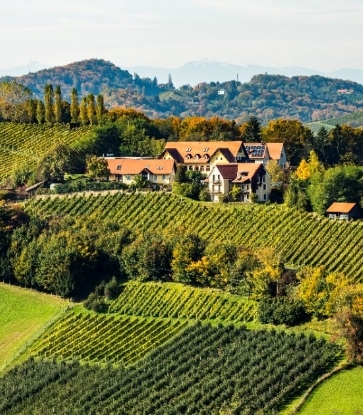Move over, California. Winemakers across North America are producing a rich diversity of wines—and winning awards. There are few rules or laws around what can be grown here, which gives vintners the freedom to try almost anything. And the wide array of microclimates means that there’s bound to be something for everyone. New York’s Finger Lakes region may specialize in cool-climate wines like riesling, but in Arizona’s dry, arid Verde Valley, varieties like grenache can flourish. Thousands of vineyards and wineries across the region are currently closed for tastings due to Covid-19, but most continue to ship or deliver locally.
Here are eleven North American wine regions to put on your list.
Canada

British Columbia
One of Canada’s premier wine regions is the Okanagan Valley in British Columbia. The 50th parallel is the outer limit for viticulture, and the Okanagan is right below it. Thanks to a variety of microclimates ranging from cool to semi-arid, the region can produce pinot noir, Bordeaux blends, syrah, world class riesling, chardonnay, sparkling wines, and of course ice wines, a Canadian favorite. There are 185 wineries in the Valley alone.
Look for wines from Burrowing Owl Estate Winery, which won double gold for their 2015 syrah at the Berlin International Wine Competition. You can also take a virtual tour of the winery and follow along with a variety of tasting notes.
Quebec
Two hours outside Montreal, in the Eastern Townships, the Brome-Missisquoi wine route runs 140km (87mi), linking 20 wineries and beckoning tasters on two wheels to cruise along four wine cycling trails. Wineries here grow cool-climate grapes like pinot gris and frontenac and, as in British Columbia, produce a spread of white, red, rose, sparkling, and ice wines (and cider).
Look for La Belle Alliance winery, founded by Carolyn and Brock Dagenais. They produce six bottles, including their 2017 Entre, an orange wine that the Dagenais say “has notes of nectarine and candied ginger on the nose and the palate.”
United States

Verde Valley, half an hour outside Sedona, is literally the hottest wine growing region in North America. The hot, arid climate is working for vineyards: the Verde Valley Wine Trail has 20-plus wineries, many producing bold reds from cabernet franc, syrah, zinfandel, grenache, and refreshing whites (chardonnay, viognier) that go down well in the toasty climate.
Look for bottles from Chateau Tumbleweed, which sources its grapes from a dozen local vineyards. The resulting wines include the 2017 Dr. Ron Blot, a Rhône-blend and the 2018 The Descendants (one-third verdelho, two-thirds viognier).

California
Beyond Napa and Sonoma, California’s other world-class growing region is its Central Coast. There are more than 200 wineries here, from Santa Barbara to just south of San Francisco, and the area has two distinct climates: the cool, coastal areas and those warmer and inland. The coastal areas have cloud cover, a result of moist air, so cool-climate grapes like chardonnay and pinot noir thrive here. Inland, grenache, cabernet sauvignon, and syrah (among others) flourish. The 350-mile stretch encompasses 40 AVAs, among them are Santa Rita Hills and Paso Robles.
Try wines from Desparada, a female-run winery in Paso Robles, where tasting notes are as non-traditional as the winery itself. The 2017 sauvignon blanc, for example, is described as “the moment the piñata breaks, unicorns, licking the Dolomites, South Tyrolean herbs.”
Or for a Santa Barbara wine, Municipal Winemakers is David Potter’s Funk Zone winery in a former dive shop. There are seven bottles under the Muni line, including a dry, drinkable riesling made with grapes from Kick On Ranch in Los Alamos.

Colorado
The high-altitude Grand Valley wine region sits over 4,000 feet above sea level, and the higher you go, the stronger the sun is. This more intense exposure leads to grapes with thicker skin, deeper pigmentation, and stronger tannins. Grand Valley has 30 wineries and vineyards, and the high, dry terroir yields merlot, cabernet sauvignon, syrah, and chardonnay.
Try Varaison Vineyards and Winery, Colorado’s most unique winery on the grounds of a handsome brick Victorian house. Kristin and Ron West produce wines with grapes from their own estate (like a chardonnay with notes of pear and kiwi) and from other vineyards in Grand Valley (their pinot noir grapes grow along the banks of the Gunnison River).

New York
The two main wine-growing regions in New York are the Finger Lakes and Long Island. There are more than 100 wineries in the Finger Lakes, where Keuka, Seneca, and Cayuga Lakes create a relatively temperate climate. The resulting wines are aromatic whites like gewürztraminer and riesling, and cool-climate reds like pinot noir and cabernet franc. Each of the lakes has its own wine trail you can do by car or on two wheels.
On Long Island, 50-plus vineyards grow a wide range of reds, whites, dessert wines, and sparkling wines, from light-bodied reds like lagrein and refosco to mostly-dry roses and crispy whites that pair perfectly with local seafood like Blue Point Oysters.
Look for the Finger Lakes winery Hosmer Winery, where young vintner Julia Hoyle and her winegrowing crew produce several rieslings as well as reds like a 2017 lemberger with notes of plum, orange, and vanilla.
From Long Island, Sparkling Pointe is the only winery exclusively producing sparkling wine in the traditional Méthode Champenoise. Champagne varietals are planted across 40 acres.

North Carolina
North Carolina has three wine growing regions—coastal, mountain, and the Piedmont plateau— featuring 185 wineries, more than 525 vineyards, and six AVAs. Drive (or cycle) one of North Carolina’s wine trails to taste what’s being grown. In the coastal region, muscadine grapes, native to North Carolina, are used for sweet wines. Vineyards in the mountainous and Piedmont regions of the state grow viognier, chardonnay, syrah, cabernet sauvignon, cabernet franc, and merlot.
Try wines from Laurel Gray Vineyards in Swan Creek. The vineyard started in 2001, and across 15 acres now grow pinot gris, cabernets franc and sauvignon, chardonnay, and merlot.

Virginia
The southern United States is better known for bourbon and whiskey, but Virginia is producing wines across 10 regions, from the Blue Ridge up to Northern Virginia. The state’s wineries vary in elevation; its eastern border is coastal, so vineyards here are at sea level, but in the mountainous west, a vineyard might be at 3,000 feet. Soil varies from limestone to loam and red clay. Such diversity helps Virginia’s wineries grow a wide range of grapes. There are roughly 275 wineries in Virginia growing grapes familiar (chardonnay, merlot) and fresh (petit manseng).
Find wines from King Family Vineyards, founded by Ellen King and her late husband David. Try the award-winning bottlings of Mountain Plains Red, a blend of petit verdot, cabernet franc and merlot.

Washington
The state boasts more than 1,000 wineries producing 70 varieties of wine (59% red, 41% white). Like neighboring Oregon, its climate is temperate, with little rain during the growing season. Cabernet sauvignon dominates, followed by merlot, but chardonnay and riesling also have a good showing.
Explore the wines of Arbor Crest Wine Cellars, perched on a cliff above the Spokane River Valley, from Kristina Mielke van Löben Sels and her husband Jim. Partnering with five Columbia Valley vineyards, Arbor Crest produces over a dozen reds (merlot, cabernet sauvignon) and a handful of whites such as a sangiovese and riesling blend blush.
Or find some of the region’s siegerrebe (“victory wine” in German), delightfully summery orange muscat, and mourvèdre.

Oregon
An hour’s drive from Portland is the hundred-mile-long, 60-mile-wide Willamette Valley, home to 756 vineyards and 592 wineries. The climate is temperate overall, with cool, wet winters and dry, warm (but not hot) summers. This plus the valley’s location just 50 miles from the Pacific Ocean have made it the western US region for cool climate varieties. Two-thirds of what’s produced here is pinot noir, followed by pinot gris, and chardonnay.
Try wines from Eyrie Vineyards, which was started in 1965 by Diana and David Lett. It was the first in Oregon to cultivate pinot noir and pinot gris, bottling them in 1970. Today, pinot noir, pinot blanc, pinot gris, and a crisp muscat ottonel are made from its 50,000 vines.
Or try recommendations from sommelier and Robert Parker reviewer Erin Brooks for the region’s chenin blanc or syrah.
Mexico

Baja California
Just two hours south of San Diego, in Baja California, is Valle de Guadalupe, where a significant portion of the country’s wine is grown—including a bottling from El Cielo winery that took home gold at international wine competition Concours Mondial de Bruxelles in 2019. It has become a hot destination for oenophiles, who check into boutique hotels like Casa Mayoral, Campera Hotel, and upmarket Bruma. There are more than a hundred wineries in the Valle, where the mild, wet winters and hot, dry summers make the climate similar to that of Spain and parts of Chile.Monte Xanic is Mexico’s first boutique winery, opening in 1988. Taste whites (chardonnay or chenin blanc), reds (such as Bordeaux varietals) or a mix of both. The winery has taken home a number of awards, including two silvers at the 2020 San Francisco Chronicle Wine Competition.
Read more on these destinations and get inspired for future travel at travelguide.michelin.com or with one of our Green Guides, available at your local bookseller.
Hero image: Domaine des Côtes d'Ardoise, Dunham, Quebec, Canada. Photo © Jean-François Bergeron / Tourisme Cantons-de-l’Est



















